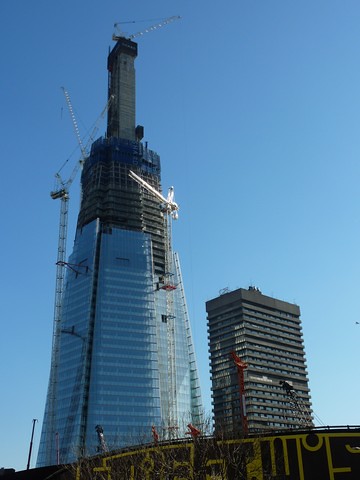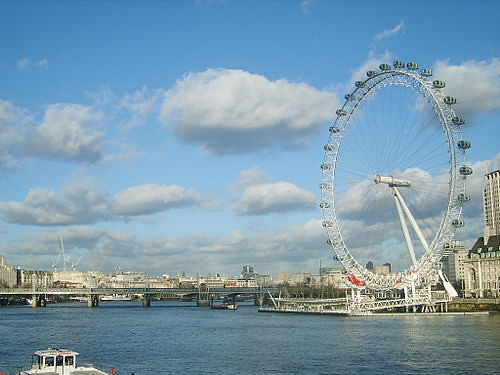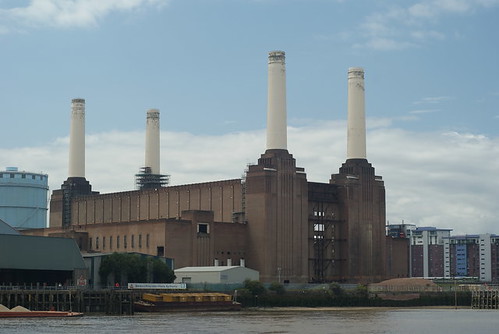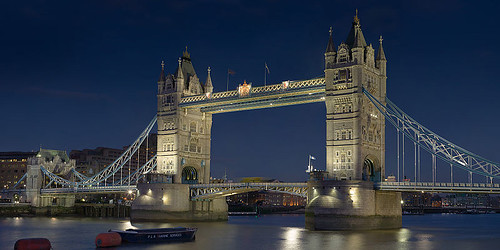Last week I took you on a quick tour of a few of the big, weird or distinctive landmarks that dot London on the north side of the River Thames. Here in Part Two we move south of the river and look at everything marked with a yellow splodge on the handy Google map:
View London Landmarks in a larger map
Tower Bridge: I think this may be my favourite of the sites we’ve looked at, though I can't put my finger on why. I suppose it's because I'm a sucker for bridges anyway, and this one is such a fairy tale of a thing. And it's so... London. Not that St. Paul's and Big Ben aren't London as well... I guess it's just that for me, Tower Bridge is special.
The famous bridge (technically known as a "bascule bridge", thank you Wikipedia) officially opened in 1894. It's the furthest downstream bridge across the Thames in London, and was built as a drawbridge to allow shipping access to the port facilities between it and London Bridge, just upstream. It's called Tower Bridge because its northern end meets the shore right at the Tower of London, meaning it’s a kind of tourist two-for-one. The bridge is currently not lifting, because it's nearing the end of a three-year restoration project, but it's due to open to shipping traffic again on April 9, 2011! I might have to put that date on my calendar and make special trip down. (The lifting schedule is here.)
And it turns out that the famous story about the American businessman who bought the old London Bridge and had it shipped to Arizona and reassembled, thinking he was getting Tower Bridge is actually just an urban legend... sad.
During the few months when I was living in the north of the city, I devised a 10km running route home that took me across Tower Bridge and every time I ran across that bridge and past the Tower of London, even on evenings when I was frustrated by work, or tired, or just distracted, I consciously forced myself to pause (mentally, if not physically) and just think about where I was and what I was looking at. It just gives me a buzz.
Ok, now for the newest addition to London’s skyline, which is already a dominant feature, though it’s not actually finished yet:
The Shard: Naturally, these kind of skyscraper projects are partly about being the tallest, and though the Shard will be the tallest building in Western Europe, it will still be downright titchy compared with the really really tall buildings out there (like the Petronas Towers). It will certainly be the tallest in Britain, and, as I said, the tallest in Western Europe (for the time being), but at a completed height of 310 metres, it will be merely 45th tallest building in the world.
certainly be the tallest in Britain, and, as I said, the tallest in Western Europe (for the time being), but at a completed height of 310 metres, it will be merely 45th tallest building in the world.
The Shard: Naturally, these kind of skyscraper projects are partly about being the tallest, and though the Shard will be the tallest building in Western Europe, it will still be downright titchy compared with the really really tall buildings out there (like the Petronas Towers). It will
 certainly be the tallest in Britain, and, as I said, the tallest in Western Europe (for the time being), but at a completed height of 310 metres, it will be merely 45th tallest building in the world.
certainly be the tallest in Britain, and, as I said, the tallest in Western Europe (for the time being), but at a completed height of 310 metres, it will be merely 45th tallest building in the world.
Still, it’s been interesting to watch it go up. It’s visible from all over, and I see it every morning from the bus as it chugs down the Old Kent Road to deliver me to work. The Shard already thrusts so far above the skyline around it that it’s hard not to notice. It may not really rank among the tallest in the world, but for London – a city not known for its skyline - it’s still huge. In fact, you could put the Gherkin on top of St. Paul’s Cathedral, the Shard would still be 21 metres taller.
And it looks like it will be quite a pretty thing when it’s completed in 2012 – all glass and shiny and interestingly triangular. It will house office space, high-end residential apartments, a spa, a five-star hotel, and public viewing galleries and an open-air observation deck on the 68th – 72nd floors. I’m sure that observation deck will be popular, especially since, unlike most other tall London Landmarks like the Monument and St. Paul’s, they will have high speed lifts (elevators) to carry people up to the top. Sadly, St. Paul’s lacks this crucial feature. Christopher Wren, what were you thinking?
The London Eye: The Eye is currently properly known as the EDF Energy London Eye but was previously known as the Merlin Entertainments London Eye and the British Airways London Eye. (Rumour has it that when the current sponsorship deal expires in 2014 it will be known as the Your Name Here for 50 Quid A Day London Eye.) It’s a gigantic ferris wheel that sits on the south bank of the Thames, roughly across from the Houses of Parliament. Visitors travel in one of 32 sealed observation pods that are big enough to hold 25 people each, and a ticket on the Eye gets you one complete revolution – about a 30 minute ride.
The London Eye: The Eye is currently properly known as the EDF Energy London Eye but was previously known as the Merlin Entertainments London Eye and the British Airways London Eye. (Rumour has it that when the current sponsorship deal expires in 2014 it will be known as the Your Name Here for 50 Quid A Day London Eye.) It’s a gigantic ferris wheel that sits on the south bank of the Thames, roughly across from the Houses of Parliament. Visitors travel in one of 32 sealed observation pods that are big enough to hold 25 people each, and a ticket on the Eye gets you one complete revolution – about a 30 minute ride.
 It’s the tallest ferris wheel in Europe, at 135m high, and is – I was shocked to discover - the most popular paid tourist attraction in the UK. I say shocked because it’s never been high on my list – it just doesn’t seem that special to me. There are big ferris wheels in other major cities, so this one seems kind of… unremarkable. Or perhaps I’m just put off by the prices for the whole thing which range from a merely usurious £16.74 for a standard adult ticket, through £19.98 for a Flexi Standard Ticket (whatever that is) up to a wallet-lightening £31.08 for a Flexi Fast Track ticket, which presumably lets you jump the queue and therefore seems downright un-English to me.
It’s the tallest ferris wheel in Europe, at 135m high, and is – I was shocked to discover - the most popular paid tourist attraction in the UK. I say shocked because it’s never been high on my list – it just doesn’t seem that special to me. There are big ferris wheels in other major cities, so this one seems kind of… unremarkable. Or perhaps I’m just put off by the prices for the whole thing which range from a merely usurious £16.74 for a standard adult ticket, through £19.98 for a Flexi Standard Ticket (whatever that is) up to a wallet-lightening £31.08 for a Flexi Fast Track ticket, which presumably lets you jump the queue and therefore seems downright un-English to me.
Then again, maybe it’s the annoying website that puts me off. A ride on the Eye is referred to there as a “flight” (gag) and at least one spot on the website calls the Eye “London’s most iconic landmark” which is just jaw-droppingly ridiculous. When you share a skyline with Big Ben, St. Paul’s Cathedral and Tower Bridge it’s beyond arrogant to claim that title.
However, a quick glance at Tripadvisor reveals that people love the thing, rave about the views and call it a must-do, so maybe I’m completely out to lunch. I guess I’ll have to save my pennies and go see for myself. Until then, I’ll just continue in my curmudgeonliness.
 Battersea Power Station: Finally, we come to the last stop on our tour of London landmarks, a bit of a far-flung visit to the bottom left hand corner of the Google map, to see the decommissioned coal-fired power station on the south bank of the Thames in the London Borough of Battersea. It’s a massive building – in fact two different power plants – that’s
Battersea Power Station: Finally, we come to the last stop on our tour of London landmarks, a bit of a far-flung visit to the bottom left hand corner of the Google map, to see the decommissioned coal-fired power station on the south bank of the Thames in the London Borough of Battersea. It’s a massive building – in fact two different power plants – that’s
actually the largest brick building in Europe and is even Grade II* listed, meaning that it’s deemed to be “particularly important” and “of more than special interest”. (This is one step down from a Grade I building which is "of exceptional interest, sometimes considered to be internationally important". The Tower of London and the Royal Albert Hall are Grade I.)
The station’s size is hard to gauge from the photo, so here are a few numbers: the overall footprint of the building is an impressive 160 metres (520 ft) by 170 metres (560 ft) and the chimneys are 103 metres tall (338 feet). That makes those chimneys a third the height of the completed Shard, and in the same ballpark as the Whiz-Gro Fertilizer Partitally Limited Company (Trademark) London Eye.
As late as the 1920s, power generation in London was a haphazard affair, with small local companies supplying a confusing and incompatible array of systems. In 1925 parliament decided that the power system needed to be unified as a single system under public ownership. The London Power Company was formed from several small companies and proposed to build a small number of large generating stations. Battersea Station A was the first of these, and was commissioned in 1933. Battersea B followed 20 years later, adding two more chimneys and creating the famous “upside-down snooker table” silhouette with which Londoners are so familiar. At its most productive, the Battersea stations produced about 509 megawatts, enough to supply about a fifth of London’s needs.
As the plant aged, operating costs increased and its capacity fell until it was finally decommissioned completely in 1983. Since that time several redevelopment proposals have been put forward, perhaps the most interesting of which was a plan to build a theme park inside the station. To this end the roof was removed to allow the large machinery to be taken out. The plan was then promptly abandoned, leaving the inner steel structure of the station exposed to the elements. The current owner of the property is an Irish company, who have plans that actually include reusing part of the station to generate power from biomass and waste, along with an eco-dome and a park. The company also proposes to fund an extension of the Underground to reach to Battersea, which would be the first privately-funded extension of the system. Residents are generally in favour of the plan, but let’s not forget here that the company is Irish, and – no offense Ireland – but Irish real estate developers have not exactly been wildly successful in the recent past. I don’t honestly think anyone in London is holding their breathe for the redevelopment of Battersea Power Station in their lifetime.
And there you have it – an overview of the interesting bits and bobs that stick out along the otherwise unremarkable London skyline. Now when you come visit you point to these places and impress other tourists with odd bits useless trivia. And if you happen to buy me a beer while you’re here… well, I wouldn’t say no.




3 Comments:
Wow...London has changed a lot since I was there in 1989...Maybe I need to revisit it.
Pam! I know it's not exactly skyline material (unless you're on the Thames), but no Globe on the south bank? Little surprised, it's one of the more memorable places Mitch and I went to so long ago (for me anyway!). Figured it was a shoe in for the post, considering your theatrical roots. Though the Gherkin and Shard were interesting, never heard of them before, they seem very sparkly.
Hey Pam! I did the "eye" about 5 years ago on a rather grey, overcast (i.e. typical) November London day. The views were okay but I wouldn't rank it high on my list of interesting sites in London. It does seem out of place somehow. Looking forward to further blogs regarding the city and getting around. Cheers! ck
Post a Comment